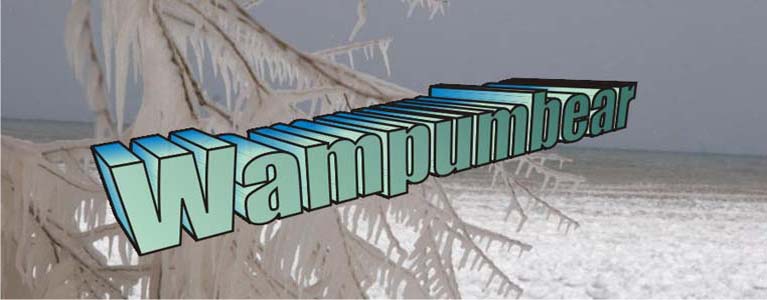Photographs (left to right): Ohiopyle Falls, Pennsylvania; Hamlin State Park, New York; Cucumber Falls, Pennsylvania

Ganondagan Belt
Origin Design and Reproduction: Richard D Hamell (Sept. 09 2013)
Original Size:
|
Beaded Length: 42.0 inches. Width: 9.0 inches. Length w/fringe: 66.0 inches |
Reproduction:
|
none |
Beads:
|
Length: 252 rows. Width: 20 rows. Total Beads: 5,040. |
Materials:
|
Warp: Leather. Weft: Artificial Sinew. |
Description:
The concept for this belt was in its formative stage in July of 2013. Ganondaman is an artifact found at Ganondagan and has became an iconic symbol for this important Seneca site. Therefore, placed in the center piece in the wampum belt. The paired braces near the ends of the belt are the foundation of the Great Longhouse of the Haudenosaunee. The dates: 1655-1687 represent the settlement duration of Ganondagan (Ganondagan) ending with the destruction of the village by The Marquis de Denonville on July 13th, 1687.
Some believe La Sale visited Ganondagan in 1669. What follows is a quote for Parkman (1869):
"Thirty-five days after leaving La Chine, they reached Irondequoit Bay, on the south side of the lake. Here they were met by a number of Seneca Indians, who professed friendship and invited them to their villages, fifteen or twenty miles distant. As this was on their way to the upper waters of the Ohio, and as they hoped to find guides at the villages to conduct them, they accepted the invitation. Dollier, with most of the men, remained to guard the canoes; while La Salle, with Galinée and eight other Frenchmen, accompanied by a troop of Indians, set out on the morning of the twelfth, and reached the principal village before evening. It stood on a hill, in the midst of a clearing nearly two leagues in compass. A rude stockade surrounded it; and as the visitors drew near they saw a band of old men seated on the grass, waiting to receive them. "
Barber (1961) suggested "Fort Hill might have been the site of the "small village" mentioned during La Salle's visit to the large village half a league distant from it in 1669. Fort Hill was fortified and stocked with corn when the French invaded in 1687. There are two springs at the base of the hill: one on the east side and one on the southwest side. E.G. Squier traced the outline of the fortification in 1849. The trench was observed to be 4 feet deep in 1876; Coates in 1893 recorded observing the charred posts. Few artifacts have been found on Fort Hill, although the Rochester Museum of Arts and Sciences has an iron axe said to have been found there in 1861. Early in the 20th century excavations on the level summit outside the northern line of the fortification revealed trade artifacts and a child's skull. In 1960 and 1961 excavations at the southern base of the hill produced nothing."
Reference:
Barber, Daniel MK. 1961. Fort Hill at Victor, New York. Fourth Report Lewis Henry Morgan Chapter Study Group, Rochester Museum of Arts and Sciences, Rochester, NY, April, 4pp.
Parkman, Francis.. 1869. La Salle and the Discovery of the Great West. France and England in North America. Little, Brown and Co. (1897), 524pp.









